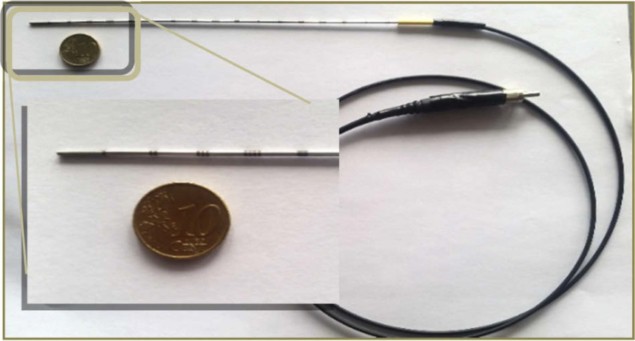
Low-dose-rate (LDR) brachytherapy, in which tiny radioactive seeds are permanently implanted into the tumour site, is a common treatment for prostate cancer; but its success is dependent upon accurate placement of the seeds into the prostate. This placement is performed under image guidance, but errors do occur, as well as subsequent seed migration.
To increase the treatment accuracy, researchers from Ireland have developed an optical fibre sensor for in vivo dose monitoring during LDR brachytherapy procedures. The sensor can be placed within the brachytherapy needle used to implant the seeds, locating it within the prostate itself, or in the transrectal biopsy guide of an ultrasound probe. This dual capability provides real-time monitoring of the radiation dose received by the tumour and the surface of the rectal wall.
According to principal investigator Peter Woulfe, from the Optical Fibre Sensors Research Centre of the University of Limerick, in vivo dosimetry is the most direct method for monitoring radiation dose delivery. By providing real-time measurements during the brachytherapy procedure, deviation or errors can be detected and seed placement optimized.
The sensor is based on a radiation-sensitive scintillator – terbium-doped gadolinium oxysulphide (Gd2O2S:Tb) – embedded in a 700 μm diameter cavity micromachined into the core of a 1 mm PMMA plastic optical fibre. When exposed to ionizing radiation, the Gd2O2S:Tb fluoresces. The emitted fluorescent light penetrates the fibre core and propagates along the fibre to a multi-pixel photon counting module.
The researchers tested the performance of their fibre dosimeter using an in-house prostate phantom and iodine-125, the radioactive source most commonly used in LDR prostate brachytherapy. Writing in Biomedical Optics Express, they report that the device demonstrated a high sensitivity of 152 photon counts/Gy and a temporal resolution of 0.1 s.
To measure stability and repeatability, the researchers inserted and removed a single iodine-125 seed with an activity of 0.361mCi over three consecutive cycles. The largest repeatability error between measurements was 4.1%, within current acceptable standards for brachytherapy dosimetry. They also confirmed that the sensor could detect activity at distances of up to 3 cm.
The researchers also investigated the angular dependency by monitoring the variation in optical signal at different angles to the dosimeter, reporting a noticeable difference in the response at different angles, with a maximum error of 1.9%. To measure the sensor’s response to accumulated radiation activity, they inserted eight seeds in various positions around the sensor. The sensor could monitor the placement of individual seeds, in addition to determining the overall radiation dose, with a maximum percentage error of 4.13%.
“This is a potentially exciting advance in monitoring the quality and safety of LDR prostate brachytherapy,” says second author Frank Sullivan, director of the Prostate Cancer Institute at NUI Galway, who is collaborating on the clinical assessment of the device. “The ability to track the actual doses being delivered, in real time, and during the implant, might well allow us to improve the quality of the ultimate outcome for patient. We look forward to linking this data with our PCI outcomes database, as a part of our future collaborative research here.”
The Origin project
Woulfe tells Physics World that this research has led to a project entitled Origin that is being coordinated by the University of Limerick. The project has the potential to dramatically reduce the risk of errors in treatments of prostate and gynaecological cancers, according to the university.
“Origin aims to deliver more effective, photonics-enabled, brachytherapy cancer treatment through advanced real-time radiation dose imaging and source localization,” Woulfe explains. “One of the project’s goals is to develop a new optical fibre-based sensor system to support diagnostics-driven therapy through enhanced adaptive brachytherapy. Optical fibres are an ideal solution for this due to their small size, flexibility and electrical passiveness.”
The three-year project aims to develop a dose-monitoring system for both LDR and high-dose-rate brachytherapy, with novel algorithms to provide 3D dose imaging and source localization. The project has been awarded funding of almost €5m from the European Union’s Horizon 2020 research and innovation programme, of which the University of Limerick has received close to €1m. Other project partners include the Galway Clinic, Vrije Universiteit Brussel, Queens University Belfast, the University of Insubria, DoseVue and Eckert and Ziegler.



